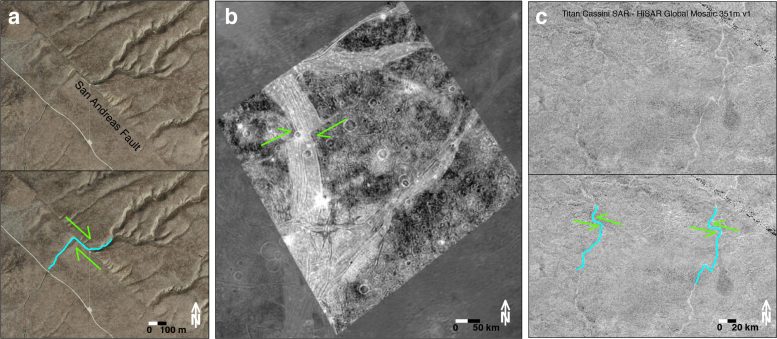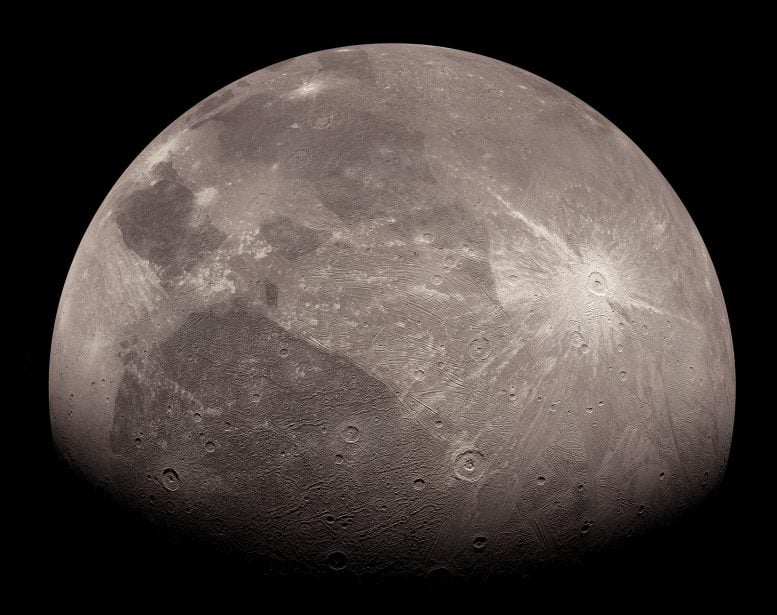
Scientists have discovered strike-slip faults on the icy moons of our solar system, similar to those seen at the San Andreas fault in California. These faults occur when fault walls slide sideways past each other. New research from the University of Hawai‘i at Mānoa, led by earth and space scientists, has explored and explained the origins of these geological features on Titan, Saturn’s largest moon, and Ganymede, the largest moon of Jupiter.
“We are interested in studying shear deformation on icy moons because that type of faulting can facilitate the exchange of surface and subsurface materials through shear heating processes, potentially creating environments conducive for the emergence of life,” said Liliane Burkhard, lead author of the studies and research affiliate at the Hawai‘i Institute of Geophysics and Planetology in the UH Mānoa School of Ocean and Earth Science and Technology.
When an icy moon moves around its parent planet, the gravity of the planet can cause tidal flexing of the surface of the moon, which can drive geologic activity such as strike-slip faulting. Tidal stresses vary as the moon changes distance from its planet because the moon’s orbit can be elliptical rather than circular.

Titan, a frozen ocean world
The extremely cold temperatures on the surface of Titan mean that water ice acts as rock that can crack, fault, and deform. Evidence from the Cassini spacecraft suggests that tens of miles below the frozen surface, there is a liquid water ocean. Further, Titan is the only moon in our solar system with a dense atmosphere, which, uniquely, supports an Earth-like hydrological cycle of methane clouds, rain, and liquid flowing across the surface to fill lakes and seas, placing it among a handful of worlds that could potentially contain habitable environments.
The NASA Dragonfly mission will launch in 2027, with a planned arrival on Titan in 2034. The novel rotorcraft lander will conduct several flights on the surface, exploring a variety of locations to search for the building blocks and signs of life.
In their investigation of the Selk crater area on Titan, the designated initial landing site for the Dragonfly mission, Burkhard and her co-author explored the potential for shear deformations and strike-slip faulting. To do this, they calculated the stress that would be exerted on Titan’s surface due to tidal forces as the moon orbits Saturn and tested the possibility of faulting by examining various characteristics of the frozen ground.

“While our prior research indicated that certain areas on Titan might currently undergo deformation due to tidal stresses, the Selk crater area would need to host very high pore fluid pressures and a low crustal coefficient of friction for shear failure, which seems improbable,” said Burkhard. “Consequently, it’s safe to infer that Dragonfly won’t be landing in a strike-slip ditch!”
Ganymede, a moon with a checkered past
In a second publication, Burkhard and her co-authors investigated the geologic history of Ganymede, Jupiter’s largest moon, in the area of Nippur/Philus Sulci by examining high-resolution data available for this region and conducting a tidal stress investigation of Ganymede’s past.
Ganymede has documented strike-slip faults on the surface, but its current orbit is too circular, as opposed to elliptical, to cause any tidal stress deformation.
The researchers found that several crosscutting bands of light terrain in the Nippur/Philus Sulci site show varying degrees of tectonic deformation, and the chronology of tectonic activity implied by mapped crosscutting relationships revealed three eras of distinct geologic activity: ancient, intermediate, and youngest.
“I investigated strike-slip faulting features in intermediate-aged terrain, and they correspond in slip direction to the predictions from modeling stresses of a higher past eccentricity. Ganymede could have undergone a period where its orbit was much more elliptical than it is today,” said Burkhard.
Other shear features found in younger geologic units in the same region do not align in slip direction with typical first-order shear indicators.
“This suggests that these features might have formed through another process and not necessarily due to higher tidal stresses,” Burkhard added. “So, Ganymede has had a tidal ‘mid-life crisis’, but its youngest ‘crisis’ remains enigmatic.”
The recent studies along with space exploration missions create a positive feedback of knowledge.
“Geologic investigations, such as these, prior to launch and arrival, inform and guide mission activities,” said Burkhard. “And missions such as Dragonfly, Europa Clipper, and ESA’s JUICE will further constrain our modeling approach and can help pinpoint the most interesting locations for lander exploration and possibly for gaining access to the interior ocean of icy moons.”
References: “Exploring the initial landing site area of Dragonfly on Titan: Insights into shear failure and strike-slip faulting at Selk crater” by Liliane M.L. Burkhard and Sarah A. Fagents, 23 August 2023, Icarus.
DOI: 10.1016/j.icarus.2023.115764
“Uncovering Ganymede’s past: Tectonics at Nippur/Philus Sulci” by Liliane M.L. Burkhard, Emily S. Costello, Bridget R. Smith-Konter, Marissa E. Cameron, Geoffrey C. Collins and Robert T. Pappalardo, 2 October 2023, Icarus.
DOI: 10.1016/j.icarus.2023.115823
The study was funded by NASA Astrobiology Institute.